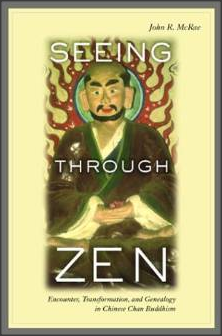
John R. McRae offers a unique and fresh look at the historical development of Chan Buddhism in China with his book, Seeing Through Zen: Encounter, Transformation, and Genealogy in Chinese Chan Buddhism. While both a Buddhist and a scholar, McRae writes with an easy, fluid, and almost childishly enthusiastic style as he sets out to unravel fiction and fantasy, myth and fact, and expose new insights into the rich heritage of Chan Buddhism.
In the preface he boldly sets forth four “rules” which govern the development of his ideas throughout the work: 1) It’s not true, and therefore it’s more important; 2) Lineage assertions are as wrong as they are strong; 3) Precision implies inaccuracy; 4) Romanticism breeds cynicism.
As many Buddhists know, Chan’s historical accounts differ dramatically from its religious accounts, but few have dared to tackle the how and why of this. Chan’s history is one of story-telling; not historical stories, but teaching stories. This isn’t specific to Chan’s history so much as it’s humanity’s history. For tens of thousands of years, humans have passed down knowledge of all kinds using stories that offer lessons from how to hunt animals, pick the right berries, and clean wounds, to preparing for death, caring for children, and working with complex social and emotional situations. Many religious anthropologists and historical sociologists speculate, based on archeological evidence, that there was likely no separation between early peoples’ spiritual and secular lives until relatively recently in human history. The longest and oldest epic poem ever written, the Mahabharata, is a wonderful example of such ancient storytelling supporting this conjecture; its early composition, scholars agree, dates back many millennia BC. The greatest story tellers often freely manipulate events, manufacture characters, and embellish as needed in order to emphasize an important point…. In Chan, the Story is the finger pointing to the moon. It’s not the finger, it’s not the moon, it’s the meaning that offers the quintessential understanding of Chan. And this is one of McRae’s central points as he takes us through a journey in time through some of the most famous Chan stories, the people they are about, and the power they invoke.
McRae offers engaging and fresh perspectives on one of the most perplexing religious mystical traditions and leads the reader to a deeper understanding of the meaning of Chinese Chan through his thought-provoking explorations. I recommend this work to anyone who is already familiar with Chan’s folklore and is interested in seeing it in a new light.
